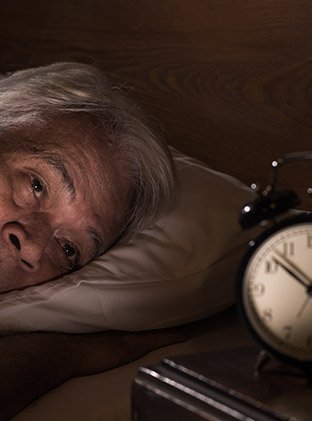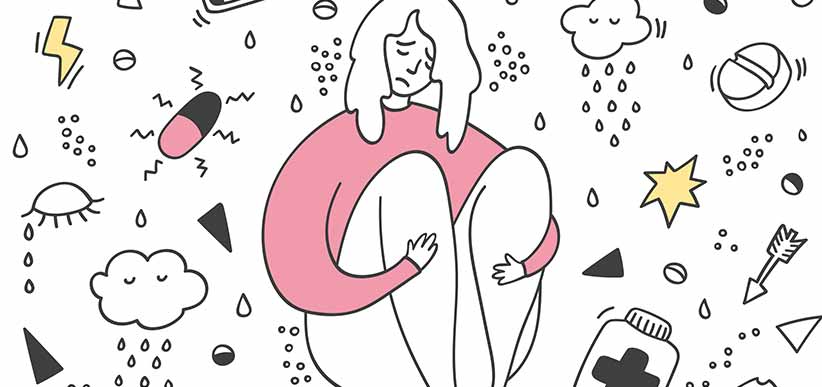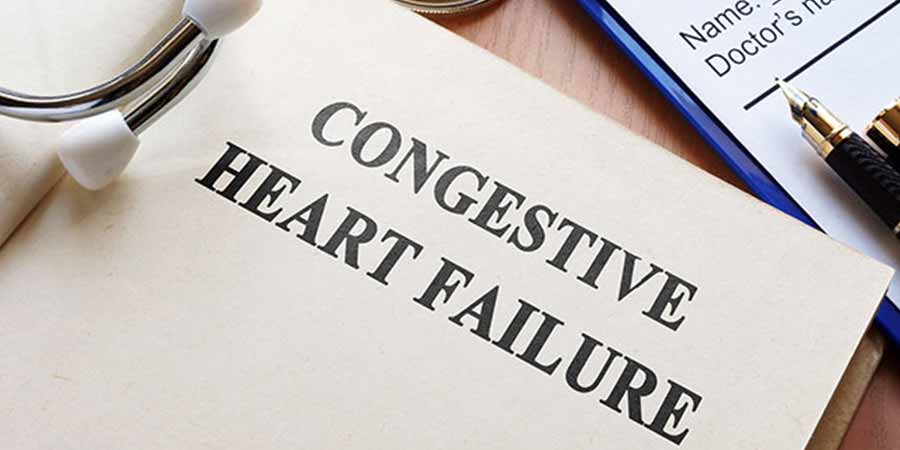
Almost everyone has days when they feel discouraged, disheartened, and a bit grouchy. Usually, these times of reduced energy and irritability last only a short time and soon vitality and enthusiasm for life returns. During these low periods, people may say they feel “depressed” or “down in the dumps,” yet rarely are they clinically depressed or grieving a significant loss.
Depressive disorders, on the other hand, are pervasive alterations in body, mood, and thoughts that significantly interfere with daily living and normal functioning, causing distress for both the person with the disorder and those around him or her. The resulting self-doubt, guilt, and anger affect the self-esteem, interpersonal relationships, and livelihood of these individuals. It is no surprise to find that suicide is also associated with depressive disorders. The risk of suicide is approximately 20 times higher among individuals with major depression, and untreated depression is the number one cause for suicide (Caruso, n.d.; Lyness, 2015).
TYPES OF DEPRESSIVE DISORDERS
Depressive disorders are common but serious and come in different forms. In order to help healthcare professionals recognize and treat depressive disorders more effectively, the American Psychiatric Association in the fifth edition of the Diagnostic and Statistical Manual of Mental Disorders (DSM-5) has identified the following types of depressive disorders.
Persistent Depressive Disorder (Dysthymia)
This disorder is a consolidation of the formerly defined chronic major depressive disorder and dysthymic disorder. It is similar to, but milder than, major depressive disorder, characterized by a chronic depressed mood that is present most of the time, identified subjectively or by observation by others, and lasts for at least 2 years in adults. In children and adolescents the mood can be irritable and must be present for at least 1 year. There is no evidence of psychotic symptoms.
This joyless disorder may begin in early childhood, adolescence, or adulthood. Although people with persistent depressive disorder experience social and occupational distress, only rarely are they hospitalized unless they threaten or attempt suicide or develop some other psychiatric disorder.
Major Depressive Disorder (MDD)

Major depressive disorder is not the occasional “down day” people ordinarily experience. Neither is it the chronic depression of persistent depressive disorder. It is a noticeable change in a person’s usual pattern of functioning that lasts two weeks or more. It is a terrible state of darkness, despair, and gloom, a debilitating condition in which people feel empty, hopeless, joyless, enervated, and believe that life is not worth living. When these people regain just a bit of strength, they may use that energy to die by suicide.
With major depressive disorder there is no history of manic behaviors, and the symptoms cannot be attributed to substance use or a general medical condition. It is now evident that bereavement and major depression are not always completely separate. Grief following a loss is a considerable psychological stressor and may generate a major depressive episode in some persons.
Gradually, without treatment, episodes of major depression recede and individuals return to their former cognitive, emotional, and physical state. Regrettably, however, recurrence is high, as is the rate of suicide. For a person who has had one episode of depression, risk of recurrence is 50%; for a person with two episodes, the risk is approximately 70%; and for someone with three episodes or more, the risk rises to around 90% (Tartakovsky, 2016).
Of persons experiencing major depression, 15% eventually die by suicide. In 2014 in the United States, over 42,000 persons died by suicide, and the lethality of depression can be elucidated by the fact that suicide is the tenth leading cause of death among the general population (AAS, 2015; CDC, 2015).
The positive findings are that more than 80% of people who are treated for major depressive disorder experience a reduction in symptoms (Goldberg, 2016; Halverson, 2016).

EPIDEMIOLOGY
In the United States, it is estimated that 15.7 million adults age 18 or older had experienced at least one major episode of depression during the year 2014. At any point in time, 3% to 5% of adults experience major depression. The estimated lifetime risk is 12%, and the prevalence of major depression in adults is 17%. Although depression is twice as prevalent in young women ages 14 to 25 years, at ages older than 65 years both men and women show a decline in depression rates and prevalence becomes similar between them. Of those meeting the criteria for a diagnosis of depression, approximately one third (35%) seek treatment (Albert, 2015; Krishnan, 2016; MHA, 2016).
Among the pediatric population in the United States, the prevalence of depression is:
- 0.5% for 3- to 5-year-olds
- 1.4% for 6- to 11-year-olds
- 3.5% for 12- to 17-year-olds
The portion of the adolescent population that has experienced depression at some point in their lives (lifetime prevalence) is 11%, and the ratio of female to male adolescents with major depression is estimated to be 2 to 1. The lifetime prevalence rates for adolescent females is 18% and for males 8%. However, in prepubertal children depression is far more common in boys than girls, with an estimated prevalence of 60% (Bonin, 2016).
Major depression is the leading cause of disability among Americans ages 15 to 44 (APA, 2016a).
SCREENING AND ASSESSING FOR DEPRESSION

The most common psychiatric disorder among the general population and the most common mental health problem in primary care patients is depression. However, even though depression is so prevalent, few patients are willing to talk about their symptoms with clinicians.
It is important that patients be directly asked about their mood, as they often fail to provide such information. Reasons for this may include the fear of being stigmatized with a mental health label, the belief that primary care clinicians do not provide care for mental health issues, and that depression is not an illness but rather a personal weakness.
When depression is untreated, there is a decrease in the quality of life, an increased risk of suicide, and poor physiological outcomes when chronic medical conditions coexist with depression. It is therefore of great benefit to screen for depression in primary care.
The U.S. Preventive Services Task Force recommends screening in the general adult population, including pregnant and postpartum women. Screening is also recommended in adolescents 12 to 18 years of age, but current evidence is insufficient to recommend screening in children 11 years or younger. Screening should be implemented with adequate systems in place in order to ensure proper diagnosis, treatment, and appropriate follow-up (USPSTF, 2016a, 2016b).
Screening can easily be done at the time of a routine health visit using short screening tools that can be self-administered by patients in the waiting area prior to being seen, or administered by a clinician.
Self-Administered Depression Screening Tools
- Patient Health Questionnaire (PHQ-9 and PHQ-2). The PHQ-9 is a multipurpose tool for screening, diagnosing, monitoring, and measuring the severity of depression as well as the presence and duration of suicide ideation. The PHQ-2 consists of the first two items of the PHQ-9, which inquire about the degree to which an individual has experienced depressed mood and anhedonia (lack of pleasure) over the past two weeks.
- World Health Organization Well-Being Index (WHO-5), a short, five-item questionnaire, is among the most widely used screening tools.
- Beck Depression Inventory (BDI) assesses depression in individuals ages 13 to 80 years, consists of 21 items, and takes five minutes for a patient or clinician to administer.
- Edinburgh Postpartum Depression Scale (EPDS), as well as the PHQ-9, have been validated in practices serving pregnant or postpartum women.
- Geriatric Depression Scale (GDS) is a 30-item “yes” or “no” self-report assessment used to identify depression in the older adult.
Sources: APA, 2016b; Bienenfeld, 2016; Topp et al., 2015; Manea et al., 2016.
The most common psychiatric disorder among the general population and the most common mental health problem in primary care patients is depression.
Comprehensive Assessment
Diagnosis of depressive disorders depends on a comprehensive clinical history and examination that includes:
- History of present illness
- Family history
- Social history
- Mental status exam
- Physical examination
- Laboratory and neuroimaging studies
- Suicide/homicide assessment
Symptoms of Depression
- Persistent feelings of sadness, emptiness, hopelessness, pessimism
- Feelings of guilt, worthlessness, helplessness
- Loss of interest or pleasure in most or all normal activities
- Anxiety, agitation, restlessness
- Angry outbursts, frustration, even over small matters
- Difficulty sleeping, early-morning awakening, or oversleeping
- Decreased energy, fatigue, tiredness, slowed speech or body movements
- Changes in appetite and/or weight
- Difficulty concentrating, remembering, making decisions
- Thoughts of death or suicide; suicide attempts
- Persistent physical symptoms such as back pain or headaches
(NIMH, 2016a; Mayo Clinic, 2016a)
Suicide/Homicide Assessment
It is important that all depressed patients be asked specifically about suicidal ideation and behavior. If there is any positive or vague response, clinicians then:
- Ask about the specific nature of the ideation, intent, whether the patient has a suicide plan, what are the means and actions available to the patient, and the lethality of those means.
- Assess for risk factors for suicide. These include prior history of suicide attempts, comorbid psychiatric and general medical illnesses, and family history of suicidal behavior.
- Determine the presence of psychotic symptoms such as delusions or command auditory hallucination.
- Assess for severe anxiety and substance-related disorders.
- Develop a safety plan for further evaluation and treatment depending on the level of risk. This may involve continued primary care follow-up alone, or referral to outpatient psychiatric or emergency room psychiatric evaluation.
- Ask the patient about homicidal ideation and behavior, and evaluate the risk of violence directed toward others.
Evaluation in an emergency department and/or hospitalization should be considered for patients at immediate risk of suicide (Lyness, 2016; Simon & Ciechanowski, 2015a).
DIAGNOSING DEPRESSION
Once all other conditions that may cause depression have been ruled out, the clinician then uses DSM-5 criteria to determine the appropriate diagnosis of depression.
Medical Diagnoses
The American Psychiatric Association (2013) identifies the criteria upon which a depressive disorder can be diagnosed. The following are two examples of such criteria.
Major Depressive Disorder (MDD) Diagnostic Criteria
a) Five or more of the following symptoms reported subjectively or observed by others have been present over a two-week period and represent a change from previous functioning; at least one of the symptoms is either a depressed mood or loss of interest or pleasure:
- Depressed mood most of the day and nearly every day
- Markedly diminished interest or pleasure in all, or almost all, activities most of the day, nearly every day
- Changes in appetite nearly every day; in children, failure to make expected weight gain
- Psychomotor agitation or retardation nearly every day
- Significant weight loss or gain (more than 5% of body weight in 1 month)
- Insomnia or hypersomnia nearly every day
- Chronic fatigue or low energy nearly every day
- Feelings of worthlessness/guilt nearly every day
- Difficulty thinking, concentrating, or making decisions nearly every day
- Recurrent thoughts of death or suicide, plans, or attempt
b) Symptoms cause significant distress in social, occupational, or other important areas of functioning.
c) Symptoms cannot be attributed to the physiological effects of a substance or other medical condition.
d) The occurrence of MDD is not better explained by another psychiatric psychotic disorder.
e) Specifiers/special features:
- With anxious distress
- With mixed features
- With melancholic features
- With atypical features
- With mood-congruent psychotic features
- With mood-incongruent psychotic features
- With catatonia
- With peripartum onset
- With seasonal pattern
Source: APA, 2013.
Persistent Depressive Disorder (Dysthymia) Diagnostic Criteria
a) Depressed mood for most of the day, for more days than not for at least two years, reported subjectively or through observation by others
b) Presence, while depressed, of two or more of the following:
- Poor appetite or overeating
- Insomnia or hypersomnia
- Low energy or fatigue
- Low self-esteem
- Poor concentration or difficulty making decisions
- Feelings of hopelessness
c) During the two-year period (one year for children or adolescents), the person has never been without the above symptoms for more than two months at a time.
d) Criteria for a major depressive disorder may be continuously present for two years.
e) There has never been a manic episode or hypomanic episode, and criteria have never been met for cyclothymic disorder.
f) Symptoms cannot be attributed to the physiological effects of a substance or another medical condition.
g) Symptoms cause major impairment in social, occupational, or other areas of functioning.
h) Specifiers include:
- With anxious distress
- With mixed features
- With melancholic features
- With atypical features
- With mood-congruent psychotic features
- With mood-incongruent psychotic features
- With peripartum onset
- With pure dysthymic syndrome
- With persistent major depressive episode
- With intermittent major depressive episodes, with current episode
- With intermittent major depressive episodes, without current episode
- In partial remission
- In full remission
- Early onset (before 21 years)
- Late onset (21 years or older)
- Mild
- Moderate
- Severe
Source: APA, 2013.
TREATMENT INTERVENTIONS
The goal of treatment intervention initially is relief of symptomatology and the restoration of baseline functioning. It is recommended that treatment consist of a combination of pharmacotherapy and psychotherapy.
Studies have shown this combination treatment to be more effective than either one alone. Pharmacotherapy can treat the symptoms of depression but does not necessarily address its causes. However, psychotherapy alone is often suggested for relatively mild depressive symptoms (Simon & Ciechanowski, 2015b).
Antidepressant Medications
How antidepressant medications work is not known for certain, but it is theorized that they increase the activity of certain mood-enhancing chemicals in the brain called neurotransmitters (e.g., serotonin, dopamine, norepinephrine).
All neurotransmitters affect mood, but they do not affect every person in the same way or to the same extent. For this reason, it may be necessary to try different antidepressants or combinations of drugs to find the most effective treatment.
In addition to client responsiveness, drugs have different costs, safety features, and maintenance considerations. These factors affect how faithfully a client follows the prescribed plan of care. Selecting a drug is based on the following factors:
- Safety: risk of suicide, medical factors, history of prior drug responses
- Effectiveness: neurotransmitter specificity
- Side effects: weight gain, dry mouth, blurred vision, sexual dysfunction
- Specific depressive symptoms
- Comorbid illnesses
- Concurrent medications and potential drug-drug interaction
- Ease of administration: daily oral dose versus monthly intramuscular injections
- Patient preference or expectations
- Patient response to antidepressants during prior depressive episodes
- Family history of response to antidepressants
- Cost of medication: out-of-pocket versus insurance-paid
(Simon & Ciechanowski, 2015b)
Psychotherapeutic Interventions
Psychotherapy is commonly referred to as talk therapy or counseling. Psychotherapy uses short-term approaches that have been found to be effective for the treatment of psychiatric disorders including depression. It is effective as a primary treatment for major depression.
The role of psychotherapy is to help patients develop coping strategies to deal with everyday stressors. It is the therapist’s responsibility to provide a safe environment and a caring therapeutic milieu. Psychotherapeutic approaches are employed by healthcare practitioners who specialize in psychotherapy. These professionals may be advanced-practice nurses, marriage and family therapists, social workers, psychologists, and psychiatrists.
There are various types of psychotherapy that can be provided in a variety of formats and approaches, and the choice of the most appropriate method is based partly on the patient’s specific problem or diagnosis.
Types of Therapy
- Individual therapy involves only the patient and the therapist in private sessions.
- Group therapy involves two or more patients and the therapist participating in therapy at the same time. They can share their experiences and hear that others feel the same way and have had similar experiences.
- Marital/couples therapy helps spouses and partners deal with troublesome issues in their lives and learn new behaviors.
- Family therapy relies on awareness that the family is a major part of the team that helps persons with mental illness improve. It is helpful for family members to understand what the depressed person is experiencing, how they can help, and how they can cope.
Therapeutic Approaches
- Psychodynamic therapy is based on the assumption that the past repeats itself in the present in ways that are painful for the patient. The goal of psychodynamic therapy is to gain understanding and learn to cope better with these feelings by talking about experiences.
- Interpersonal therapy is a time-limited (usually three to four months), structured treatment that focuses on current relationships and the connection between recent adverse life events and depression.
- Cognitive behavior therapy (CBT) is designed to help identify and change patients’ inaccurate perceptions both of themselves and the world around them. It includes education, relaxation exercises, coping skills training, stress management, or assertiveness training.
- Mindfulness cognitive therapy is a group program used to delay or prevent recurrence of major depression, and it may also reduce depressive symptoms. This therapy combines the clinical application of mindfulness meditation (the purposeful, nonjudgmental attention to the present moment) with elements of cognitive behavior therapy.
- Supportive psychotherapy or counseling is used to assist patients to cope with illness, deal with a crisis, or treat depression by improving self-esteem, psychological functioning, and adaptive skills, focusing on current, difficult relationships and maladaptive patterns of behavior and emotional responses.
RESOURCES
Beck Depression Inventory II
http://www.pearsonclinical.com/psychology/products/100000159/beck-depression-inventoryii-bdi-ii.html
Depression (National Institutes of Mental Health)
http://nimh.nih.gov/health/publications/depression/
Edinburgh Postnatal Depression Scale
http://www.sadag.org/images/brochures/edinburghscale.pdf
Geriatric Depression Scale (Short Form)
http://geriatrictoolkit.missouri.edu/cog/GDS_SHORT_FORM.PDF
Patient Health Questionnaire (PHQ-9)
http://www.integration.samhsa.gov/images/res/PHQ%20-%20Questions.pdf
WHO-5 questionnaires
https://www.psykiatri-regionh.dk/who-5/Pages/default.aspx
REFERENCES
Albert P. (2015). Why is depression more prevalent in women? J Psychiatry Neurosci, 40(4), 219–21.
American Association of Suicidology (AAS). (2015). Facts and statistics. Retrieved from http://www.suicidology.org/resources/facts-statistics
American Psychiatric Association (APA). (2013). Diagnostic and statistical manual of mental disorders (5th ed.) (DSM-5). Washington, DC: Author.
American Psychological Association (APA). (2016a). Data on behavioral health in the United States. Retrieved from http://www.apa.org/helpcenter/data-behavioral-health.aspx
American Psychological Association (APA). (2016b). Patient health questionnaire (PHQ-9 & PHQ-2). Retrieved from http://www.apa.org/pi/about/publications/caregivers/practice-settings/assessment/tools/patient-health.aspx
Bienenfeld D. (2016). Screening tests for depression. Medscape. Retrieved from http://emedicine.medscape.com/article/1859039-overview
Bonin L. (2016). Pediatric unipolar depression: epidemiology, clinical features, assessment, and diagnosis. UpToDate. Retrieved from http://www.uptodate.com/contents/pediatric-unipolar-depression-epidemiology-clinical-features-assessment-and-diagnosis
Caruso K. (n.d.). Depression and suicide. Retrieved from http://www.suicide.org/depression-and-suicide.html
Centers for Disease Control and Prevention (CDC). (2015). Suicide facts and figures. Retrieved from https://www.afsp.org/understanding-suicide/facts-and-figures
Goldberg J. (2016). Recognizing and treating depression. WebMD. Retrieved from http://www.webmd.com/depression/symptoms-depressed-anxiety-12/treating-depression?page=3
Halverson J. (2016). Depression. Medscape. Retrieved from http://emedicine.medscape.com/article/286759- overview
Krishnan R. (2016). Unipolar depression in adults: epidemiology, pathogenesis, and neurobiology. UpToDate. Retrieved from http://www.uptodate.com/contents/unipolar-depression-in-adults-epidemiology-pathogenesis-and-neurobiology
Lyness J. (2016). Unipolar depression in adults: assessment and diagnosis. UpToDate. Retrieved from https://www.uptodate.com/contents/unipolar-depression-in-adults-assessment-and-diagnosis
Lyness J. (2015). Unipolar depression in adults: clinical features. UpToDate. Retrieved from https://www.uptodate.com/contents/unipolar-depression-in-adults-clinical-features
Manea L, Gilbody S. Hewitt C, North A, Plummer F, et al. (2016). Identifying depression with the PHQ-2: a diagnostic meta-analysis. J Affect Disord, 203, 382–95.
Mayo Clinic. (2016a). Depression (major depressive disorder): symptoms. Retrieved from http://www.mayoclinic.org/diseases-conditions/depression/basics/symptoms/con-20032977
Mental Health America (MHA). (2016). Depression. Retrieved from http://www.mentalhealthamerica.net/conditions/depression
National Institutes of Mental Health (NIMH). (2016a). Signs and symptoms of depression. Retrieved from https://www.nimh.nih.gov/health/topics/men-and-mental-health/signs-and-symptoms-of-depression/index.shtml
Simon G & Ciechanowski P. (2015a). Unipolar depression in adults and initial treatment: general principles and prognosis. UpToDate. Retrieved from https://www.uptodate.com/contents/unipolar-depression-in-adults-and-initial-treatment-general-principles-and-prognosis
Simon G & Ciechanowski P. (2015b). Unipolar major depression in adults: choosing initial treatment. UpToDate. Retrieved from https://www.uptodate.com/contents/unipolar-major-depression-in-adults-choosing-initial-treatment
Tartakovsky M. (2016). Top relapse triggers for depression & how to prevent them. Psych Central. Retrieved from http://psychcentral.com/lib/top-relapse-triggers-for-depression-how-to-prevent-them/
Topp C, Ostergaard S, Sondergaard S, & Bech P. (2015). The WHO-5 well-being index: a systematic review of the literature. Psychother Psychosom, 84(3), 167–76.
U.S. Protective Services Task Force (USPSTF). (2016a). Depression in adults: screening. Retrieved from https://www.uspreventiveservicestaskforce.org/Page/Document/RecommendationStatementFinal/depression-in-adults-screening1
U.S. Protective Services Task Force (USPSTF). (2016b). Depression in children and adolescents: screening. Retrieved from https://www.uspreventiveservicestaskforce.org/Page/Document/UpdateSummaryFinal/depression-in-children-and-adolescents-screening1
Sign up for our newsletter email list and like us on Facebook and Instagram to be among the first to know about all our special discounts and offers!
About Wild Iris Medical Education:
Wild Iris Medical Education, Inc., is a privately held, woman-owned company providing online healthcare continuing education. In 1998, we began offering online ANCC-accredited nursing continuing education courses and since then have expanded to provide CEUs for occupational therapists, physical therapists, paramedics, EMTs, and other healthcare professionals.
Accredited and Approved Nationwide.
High-quality CEU Courses since 1998.

Join Our More Than 750,000 Satisfied Customers Now!
High-quality, accredited, evidenced-based continuing education courses in an easy-to-use format designed for learning, from Wild Iris Medical Education. We’ve been providing online CE since 1998.



